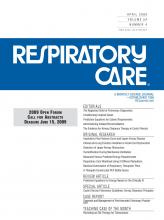Abstract
BACKGROUND: Practitioners often presume there is adequate humidification in the ventilator circuit if the Y-piece is at a specified temperature, but control of Y-piece temperature may be inadequate to ensure adequate humidification.
METHODS: In an in vitro bench model we measured water-vapor delivery with several heated humidification setups and a wide range of minute volume (V̇E) values. The setup included a condenser, hygrometry, and thermometer. First, we calibrated the system with a point-source humidifier and water pump. Then we tested the water-vapor delivery during non-heated-wire humidification and during heated-wire humidification with a temperature gradient of 3°C, 0°C, and 3°C between the humidifier and the Y-piece. We compared the results to 2 recommended humidification values: 100% saturated (absolute humidity 44 mg H2O/L) gas at 37°C (saturated/37°C); and 75% saturated (absolute humidity 33 mg H2O/L), which is the humidity recommended by the International Organization for Standardization (the ISO standard). In all the experiments the setup was set to provide 35°C at the Y-piece.
RESULTS: Our method for measuring water-vapor delivery closely approximated the amount delivered by a calibrated pump, but slightly underestimated the water-vapor delivery in all the experiments and the whole V̇Erange. At all V̇Evalues, water-vapor delivery during non-heated-wire humidification matched or exceeded saturated/37°C and was significantly greater than that during heated-wire humidification. During heated-wire humidification, water-vapor delivery varied with the temperature gradient and did not reach saturated/37°C at V̇E> 6 L/min. Water-vapor delivery with the negative temperature gradient was below the ISO standard.
CONCLUSIONS: Maintaining temperature at one point in the inspiratory circuit (eg, Y-piece), does not ensure adequate water-vapor delivery. Other factors (humidification system, V̇E, gradient setting) are critical. At a given temperature, humidification may be significantly higher or lower than expected.
Footnotes
- Correspondence: Gerald C Smaldone MD PhD, Department of Pulmonary and Critical Care Medicine, Stony Brook University Medical Center, State University of New York at Stony Brook, HSC T 17–040, Stony Brook NY 11794. Email: gsmaldone{at}notes.cc.sunysb.edu.
- Copyright © 2009 by Daedalus Enterprises Inc.







